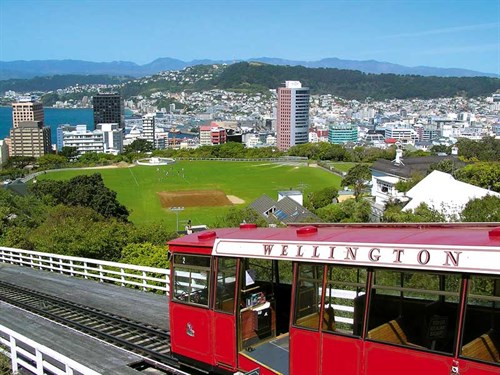
New Zealand’s capital, on the gravelly southern point of the North Island, rises sharply from the harbour it surrounds. Its tempestuous weather is one of its defining characteristics, but on a fine day it is one of New Zealand’s loveliest cities.
Coloured timber houses cram the hills and line the almost landlocked harbour, and its 19th century character is retained in structures such as Old St Paul’s Cathedral, the General Assembly Library, and the government and parliament buildings.
The city centre is all heart, and although parking is a pain, you can easily walk around it. The centre is where government, commerce, culture, and entertainment combine to generate the energy of a city on the move. Designers, architects, artists and musicians offset the conservative milieu of politicians and public servants.
Here too is Museum of New Zealand Te Papa Tongarewa and the colourful Courtenay Quarter, enlivened by buskers, artists, and performers. The Courtenay Quarter is also home to the biennial New Zealand Festival, and every year in early spring, lovers of fashion and art flock to the city to watch the acclaimed World of WearableArt (WoW) Awards Show.
Wellington is easily explored. It’s not difficult to get to the seaside suburbs of Island Bay and Lyall Bay, Days Bay, or Evans Bay. In Lyall Bay enjoy a meal at the funky Maranui Café in the former surf life-saving club building on the shore.
The city also has a wild side: Zealandia; the amazing Karori reserve; Otari-Wilton’s Bush reserve; and the rocky south coast which faces the full fury of the ocean and where seals and blue penguin haul up on the shore.
Otari-Wilton’s Bush Native Botanic Garden and Forest Reserve is a 100-hectare attractively laid-out area, five kilometres from the city on Wilton road comprises areas linked by a dramatic 90-metre canopy walkway.
Butterfly Creek: the track through this East Harbour Regional Park, accessed at various points from Eastbourne, is very popular with walkers.
The Museum of Wellington City and Sea on Queen’s Wharf: three levels, holding eight galleries, give a comprehensive overview of historic and contemporary Wellington through artefacts, writings, paintings, and photographs. Recently named one of the world’s top 50 museums by The Times UK.
Parliament grounds: visit the distinct architectural styles of the Beehive, the extension to Parliament House. There are tours and you can sit in on a house in session.
Katherine Mansfield Birthplace: the meticulously restored building on Tinakori Road is the birthplace of New Zealand’s most distinguished author and short story writer.
Waitangi Park: a recreational space on the corner of Cable Street and Oriental Parade that is used as an open-air exhibition space.
The Botanic Garden, with 25 hectares of landscaping, is just minutes from the city and accessed from many points, including the upper Cable Car terminal, comprising exotic and native forests, colourful floral displays and specialist gardens. The gardens are open daily from sunrise to sunset.
Wellington Heads is a good place to feel the power of the elements and watch the ferries go by. From the heads, you can see the fateful spot where the Wahine ferry went down in on 10 April, 1968.
The Writers Walk: this is a visual record of many of the country’s celebrated writers and poets. Text from their works presented as sculpture, appear at various points along the waterfront walkway.
Walk Wellington: there are excellent guided walking tours around the city, leaving leave from the i-SITE Visitor Centre in Civic Square daily from 10am.
Old Bank Shopping Arcade: this historical building on Lambton Quay. The historical building has been put to good use as a retail centre with 25 stores and cafés, including Smith the Grocer.
Kircaldie & Stains, Lambton Quay: this stately department store, founded by two city fathers in 1863, has since been known for its consistent standards of excellence and loved for its classic presentation.
Matiu/Somes Island: a trip to this former quarantine island is also an excellent way to get a sea perspective of the city.
Old St Pauls Church: built in 1866, this is a beautiful example of colonial gothic architecture. Stained glass windows, brass memorials, and photos record aspects of early Wellington.
Zealandia Karori Wildlife Sanctuary: one of the wonders of Wellington, the sanctuary is a seven-minute drive from the city, housing tuatara and many species of rare birds in the regenerated forest. A shuttle bus leaves from the i-SITE.






